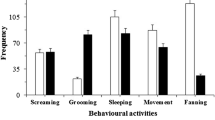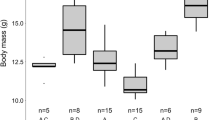Abstract
In many ant species, nuptial flight tends to be short in time and assumed to be synchronous across a large area. Here, we report that, in the upper Jordan Valley, northern Israel, massive nuptial flights of Carpenter ants (Camponotus sp.) occur frequently throughout the summer, and their alates form up to 90% of the diet of the greater mouse-tailed bat (Rhinopoma microphyllum) during this period. This fat and protein-rich diet enables female bats to lactate during summer, and the large amount of fat that both sexes accumulate may serve as an energy source for their following winter hibernation and posthibernation mating in early spring (March–April). We suggest that the annual movement of these bats to the Mediterranean region of Israel may have evolved in order to enable them to exploit the extremely nutritious forms of ant alates when the bats’ energetic demands are highest.





Similar content being viewed by others
References
Advani R (1981) Food and feeding ecology of the rat tailed bat in the Rajasthan Desert. Act Theriol 26:269–272
Anand-Kumar TCA (1965) Reproduction in the rat-tailed bat Rhinopoma kinneari. J Zool 65:147–155
Boomsma JJ, Baer BC, Heinze J (2005) The evolution of male traits in social insects. Annu Rev Entomol 50:395–420
Brigham M (1990) Prey selection by big brown bats (Eptesicus fuscus) and common nighthawks (Chordeiles minor). Am Mid Nat 124:73–80
Dunn RR, Parker C, Geraghty M, Sanders NJ (2007) Reproductive phenologies in a diverse temperature ant fauna. Ecol Entomol 32:135–142
Fenton MB, Morris GK (1976) Opportunistic feeding by desert bats, Myotis spp. Can J Zool 54:526–530
Folgarait PJ (1998) Ant biodiversity and its relationship to ecosystem functioning: a review. Bio Conserv 7:1221–1244
Gaur BS (1980) Roosting ecology of the Indian desert rat-tailed bat, Rhinopoma kinneari Wroughton. In: Wilson DE, Gardner AL (eds) International bat research conference (5, 1978, Albuquerque). Texas Tech Press, Lubbock, pp 125–128
Gloor S, Stutz H-PB, Ziswiler V (1995) Nutritional habits of the noctule bat Nyctalus noctula (Schreber, 1774) in Switzerland. Myotis 32:231–242
Gould E (1978) Opportunistic feeding by tropical bats. Biotropica 10:75–76
Habersetzer J (1981) Adaptive echolocation sounds in the bat Rhinopoma hardwickei: a field study. J Comp Physiol 116:63–76
Harrison DL, Bates PJJ (1991) The mammals of Arabia, 2nd edn. Harrison Zoological Museum, Sevenoaks, p xvi + 354
Hölldobler B, Bartz SH (1985) Sociobiology of reproduction in ants. In: Hölldobler B, Lindauer M (eds) Experimental behavioral ecology and sociobiology. Gustav Fischer Verlag, Stuttgart, pp 237–257
Hölldobler B, Wilson EO (1990) The ants. Belknap, Cambridge
Jaffe S (1988) Climate of Israel. In: Yom-Tov Y, Tchernov E (eds) The zoogeography of Israel. Dr. W. Junk, Dordrecht, pp 79–74
Kelly D (1994) The evolutionary ecology of mast seeding. Trends Ecol Evol 9:465–470
Kravchenko VD, Fibiger M, Hausmann A, Müller GC (2007) The lepidoptera of Israel. In: Müller GC, Kravchenko VD, Hausmann A, Speidel W, Mooser J, Witt T (eds) Pensoft series faunistica vol. 2, Noctuidae 63. Pensoft, Sofia
Kugler J (ed) (1989) Plants and animals of the Land of Israel—insects. Ministry of Defense, Tel Aviv
Kunz TH, Whitaker JO Jr, Wadanoli MD (1995) Dietary energetics of the Mexican free-tailed bat (Tadarida brasiliensis) during pregnancy and lactation. Oecologia 101:107–115
Kurta A, Bell GP, Nagy KA, Kunz TH (1989) Energetics of pregnancy and lactation in free-ranging little brown bats—Myotis lucifugus. Physiol Zool 62:804–818
Leshem Y, Yom-Tov Y (1998) Routes of migrating soaring birds. Ibis 140:41–52
Levin E, Yom-Tov Y, Barnea A, Huchon D (2008) Genetic diversity and phylogeography of the greater mouse-tailed bat Rhinopoma microphyllum (Brünnich, 1782) in the Levant. Act Chirop (in press)
Mendelssohn H, Yom-Tov Y (1999) Mammalia of Israel. The Israel Academy of Sciences and Humanities, Jerusalem
Norberg UM, Rayner JMV (1987) Ecological morphology and flight in bats (Mammalia; Chiroptera) wing adaptations, flight performance, foraging strategy and echolocation. Phil Trans Royal Soc London 87:335–427
Pine RH, Clark DR, Lufriu T (1975) Yet another instance of bat versus ant. Mammalia 39:509–510
Podulka S, Rohrbaugh RW, Bonney R (2004) Handbook of bird biology. Cornell Laboratory of Ornithology, Ithaca
Redford KH, Dorea JG (1984) The nutritional-value of invertebrates with emphasis on ants and termites as food for mammals. J Zool 203:385–395
Schlitter DA, Qumsiyeh MB (1996) Rhinopoma microphyllum. Mamm Spec 542:1–5
Sharifi M, Hemmati Z (2002) Variation in the diet of the Greater mouse-tailed bat, Rhinopoma microphyllum (Chiroptera: Rhinopomatidae) in south-western Iran. Zool Middle East 26:65–70
Simmons NB (2005) Order Chiroptera. In: Wilson DE, Reeder DM (eds) Mammal species of the world: a taxonomic and geographic reference, 3rd edn. vol. 1. Johns Hopkins University Press, Baltimore, pp 312–529
Sparks WD, Valdez EW (2003) Food habits of Nyctinomops macrotis at maternity roost in Mexico, as indicated by analysis of guano. South Nat 48:132–135
Van Schaik CP, Terborgh JW, Wright SJ (1993) The phenology of tropical forests: adaptive significance and consequences for primary consumers. Annu Rev Ecol Syst 24:353–377
Whitaker JO Jr (1988) Food habit analysis of insectivorous bats diet. In: Kunz TH (ed) Ecological and behavioral methods for the study of bats. Smithsonian Institution Press, Washington D.C., pp 171–189
Whitaker JO Jr (2004) Prey selection in a temperate zone insectivorous bat community. J Mamm 85:460–469
Whitaker JO Jr, Rodriguez-Duran A (1999) Seasonal variation in the diet of Mexican free-tailed bat, Tadarida brasiliensis antillarum (Miller) from a colony in Puerto Rico. Caribbean J Sci 35:23–28
Whitaker JO Jr, Shalmon B, Kunz TH (1994) Food and feeding habits of insectivores bats from Israel. Mamm Biol 59:74–81
Acknowledgements
We thank Abraham Hefetz, John O. Whitaker, and Robert B. Suter for reading and commenting on an early draft, Naomi Paz for editing the manuscript, Tamar Katzav-Gozansky and Shai Meiri for fruitful discussions, and Armin Ionescu-Hirsch for identifying the ants. We thank two anonymous reviewers for their helpful comments. This work was supported by The Open University of Israel Research Fund to AB and by the Israel Cohen Chair for Environmental Zoology to YYT.
Author information
Authors and Affiliations
Corresponding author
Rights and permissions
About this article
Cite this article
Levin, E., Yom-Tov, Y. & Barnea, A. Frequent summer nuptial flights of ants provide a primary food source for bats. Naturwissenschaften 96, 477–483 (2009). https://doi.org/10.1007/s00114-008-0496-3
Received:
Revised:
Accepted:
Published:
Issue Date:
DOI: https://doi.org/10.1007/s00114-008-0496-3




